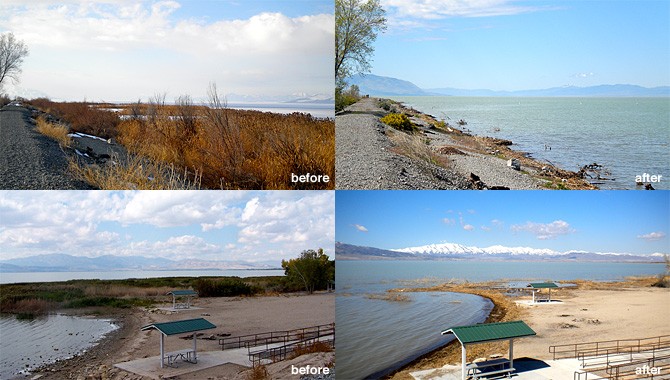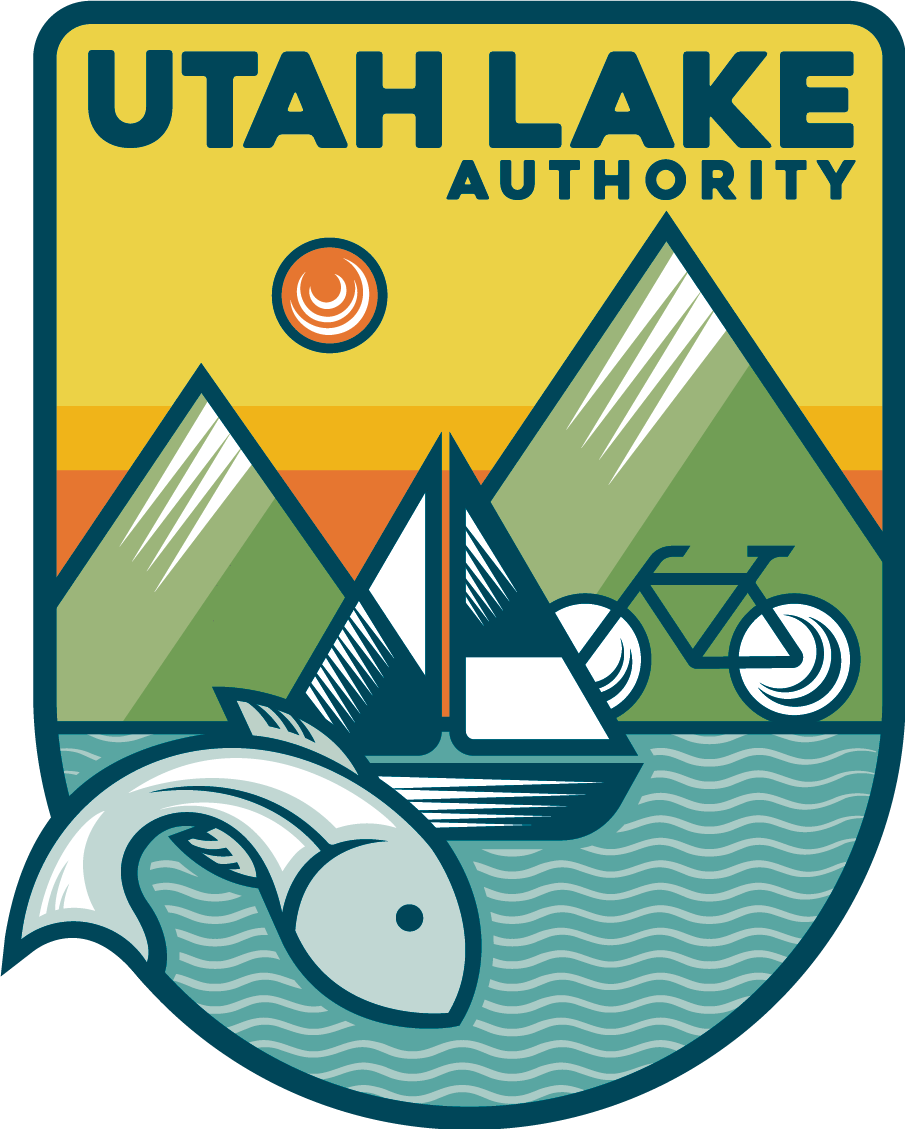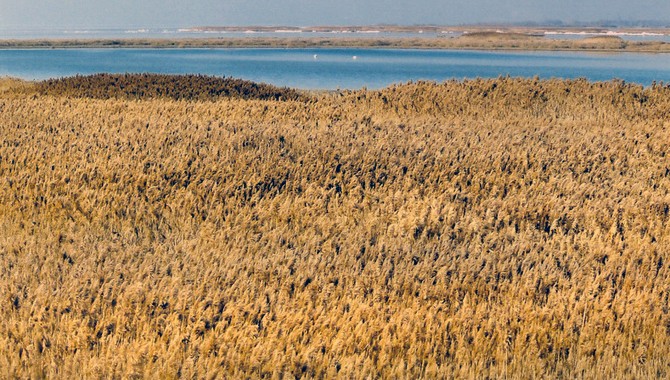Last year, we began treatment on 250 acres of phragmites growing in Saratoga Bay and it has proven to be a great success! Well,we’re about to do it again, only we’re expanding the operation to 1,500 acres in two different areas. The first is 750 acres along the north shore of Utah Lake. The other area is 750 acres between the Utah Lake State Park and Provo Bay. Once these areas are underway, we will have either finished or started treatment on approximately 25 miles of shoreline! Almost 35% of the estimated 5,500 acres of the phragmites around the lake will be in some stage of treatment. This exceeds the expectations we had when we began the process just four years ago!
You may recall reading this article on our website, where it describes how much of the shoreline of Utah Lake has been taken over by invasive plant species including a reed species called phragmites (Phragmites australis), and tree species including saltcedar or tamarisk (Tamarix spp), and Russian olive (Elaeagnus angustifolia). These are ongoing threats in much of the nation and continue to grow in Utah.
One of the goals of the Utah Lake Master Plan, which is the management plan for Utah Lake, is to control and effectively manage invasive species in and around the lake and to minimize their negative effects on the lake’s natural resources. It is our desire to return the shoreline near important recreation areas, access points, and urban interface areas to a more natural state which was prevalent just 15 years ago. It’s a problem we need to continue addressing!
This project is certain to spark a lot of interest and raise some questions. We’ve addressed some of them below. If you have further questions, feel free to contact us.
Who is involved?
Answer: The Utah Division of Forestry, Fire & State Lands (FFSL), which manages the shoreline and bed of Utah Lake, is working with the Utah Lake Commission, Utah County, and other lake stakeholders to restore the lake’s shoreline.
What will be happening and when will it occur?
Answer: Initial groundwork to treat phragmites to create a buffer between uninvaded land and the helicopter spray area has already begun, and will continue throughout the winter and into the spring. Residents will see county weed crews and contractors working to prepare for the aerial spray that will be conducted in early August. Their work will continue after the spray as well.
Starting at the beginning of August, and continuing for up to several weeks, aerial treatment by helicopter will be conducted on approximately 700 acres on the north end of the lake (see map links below), and 700 acres between the Utah Lake State Park and Provo Bay (see map link below). Aerial treatment will be on phragmites growing beyond a 50-100 foot buffer that crews will be hand treating.. This is a safe distance to eliminate potential damage to any desirable plants, including agricultural crops. We ask that the public stay away from the treatment area during the aerial spray.
The herbicide being used on the phragmites is an aquatic-rated glyphosate (similar to RoundUp®) called AquaNeat®. This product was created specifically for aquatic environments. It is most effective when applied after the phragmites produce tassels (seed heads) and begin drawing nutrients into their root system, which can be as early as mid summer to early fall. Due to low water conditions this year, the phragmites has matured quickly. Treatment will begin at the beginning of August and could last for several days to weeks, depending on wind conditions. The treatment regimen is one approved by FFSL, the Utah Department of Agriculture,and the Utah Division of Wildlife Resources. Similar practices are used on other lake and wetland areas around the state.
Mechanical treatment and removal of tamarisk, Russian olive and other invasive trees along the shoreline in select areas will take place in the fall and spring. Tree stumps will also be treated with Aqua Neat® to prevent regrowth.
Where will treatment take place?
Answer: This year’s project will be in two different areas: the north end of Utah Lake between the Jordan River and the Lindon Boat Harbor; and on the east side between the Utah Lake State Park and Provo Bay. Both areas will have approximately 750 acres of phragmites treated that is growing adjacent to and in the lake. The following maps show where the treatment will occur.
- Map 1: North End (West)
- Map 2: North End (Middle)
- Map 3: North End (East)
- Map 4: Utah Lake State Park to Provo Bay
How long will the project last?
Answer: Each section is treated over three years. We expect 80% removal of phragmites after the first treatment; 90% removal after the second; and close to 100% after the third year of treatment.
Will this work?
Answer: Yes! A pilot project on 100 acres on the east side of the lake has removed approximately 98% of the phragmites after three years, and a significant amount of tamarisk and Russian olive. The pictures below show the before and after results of those efforts.
Will you burn the phragmites?
Answer: Hopefully. While burning is not an effective treatment method on its own, burning coupled with spraying can be very effective. We hope that weather conditions will enable us to burn the treated, dead phragmites during the winter or spring.
How will the dead phragmites be removed?
Answer: Burning the treated, dead phragmites is our preferred removal method. If the weather does not cooperate to allow burning, the phragmites will naturally decompose. It will just take longer. In our initial project on the east side of the lake, most of the phragmites broke down naturally over the three year treatment program. Specialized equipment has been purchased to help speed up that process.
How is this project funded?
Answer: A $59,000 grant through the Utah’s Watershed Restoration Initiative was received to cover the costs of the herbicide, aerial application, and mechanical removal of other invasive trees between the Utah Lake State Park and Provo Bay. A $113,000 grant was received through the Utah Department of Agriculture and Food Invasive Species Mitigation Grant. Considerable manpower and coordination is also being provided by Utah County, Utah Lake Commission, and FFSL.
Again, if you have further questions, please feel free to contact us.


I’m wondering what you do after you remove the invasive species trees and phragmites are performing essential roles in the lake’s habitat, specifically accumulating toxic heavy metals in their biomass, holding soils in place so they don’t wash into the lake, creating wildlife habitat, and drawing CO2 from the air, etc. I did not see any mention of replanting natives that performed these roles.
If the natives are not able tolerate the level of toxins that have accumulated in the water and soils, these invasives may be necessary to return the lake to a place where natives can again be replanted and thrive.
I’d appreciate knowing what research has been done in this area. Thank you for working so hard to bring Utah Lake back and make it beautiful for generations to come.
I’d like to know if you have suggestions on how to eliminate them in a residential setting. I have a next door neighbor who intentionally grew them in their backyard and they are invaded all surrounding yards. After a polite request to remove them was denied, I’m not sure what step to take next. Thanks for your work.
Sounds like you know exactly what a tough situation we’re facing! I’d recommend contacting the Utah County Public Works Department’s weed division to see what recommendation they have on how to deal with this issue.